 , though, that shouldn’t be that much of a Read More
, though, that shouldn’t be that much of a Read More
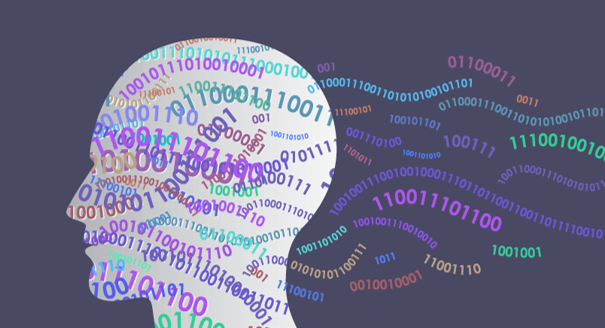
Emerging Memories Branch Out – a Q&A
 , though, that shouldn’t be that much of a Read More
, though, that shouldn’t be that much of a Read More

 , though, that shouldn’t be that much of a Read More
, though, that shouldn’t be that much of a Read More
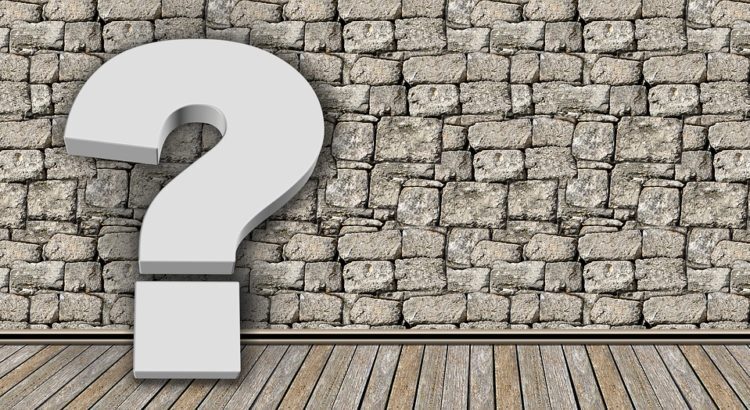
Whether storage is already a main focus of your career or may be advancing toward you, you’ll definitely want to attend the flagship event for storage developers – and those involved in storage operations, decision making, and usage – SNIA’s 19th annual Storage Developer Conference (SDC), September 11-14, 2017 at the Hyatt Regency Santa Clara, California. Read More
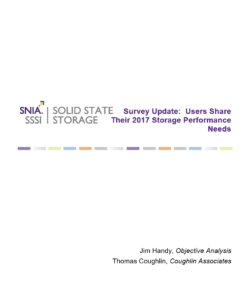 New on the Solid State Storage website is a whitepaper from analysts Tom Coughlin of Coughlin Associates and Jim Handy of Objective Analysis which details what IT manager requirements are for storage performance. The paper examines how requirements have changed over a four-year period for a range of applications, including databases, online transaction processing, cloud and storage services, and scientific and engineering computing. Read More
New on the Solid State Storage website is a whitepaper from analysts Tom Coughlin of Coughlin Associates and Jim Handy of Objective Analysis which details what IT manager requirements are for storage performance. The paper examines how requirements have changed over a four-year period for a range of applications, including databases, online transaction processing, cloud and storage services, and scientific and engineering computing. Read More
by Marty Foltyn
SNIA’s Persistent Memory Summit makes its fifth annual appearance in Silicon Valley next Wednesday, January 18, and if you are in the vicinity of the Westin San Jose, you owe it to yourself to check it out. 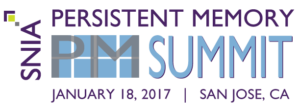
SNIA is well known for its technology-focused, no vendor-hype conferences, and this one-day event will feature 12 presentations and two panels that will “level set” the discussion, review persistent memory usage, describe applications incorporating PM available today, discuss the infrastructure and implementation, and provide a vision of the “next generation” of persistent memory.
You’ll meet speakers from SNIA member companies Intel, Micron, Microsemi, VMware, Red Hat, Microsoft, AgigA Tech, Western Digital, and Spin Transfer. Live demonstrations of persistent memory solutions will be featured from Summit underwriters Intel and the SNIA Solid State Storage Initiative, and Summit sponsors Microsemi, VMware, AgigA Tech, SMART Modular, and Spin Transfer.
Registration is complimentary but limited -visit http://www.snia.org/pm-summit for the complete agenda and how to sign up. And, if your travels don’t permit you to attend in person, the Persistent Memory Summit will be live-streamed on the SNIAvideo channel at https://www.youtube.com/user/SNIAVideo.
SNIA’s 18th Storage Developer Conference is officially a success, with 124 general and breakout sessions; Cloud Interoperability, Kineti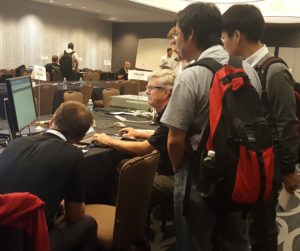 c Storage, and SMB3 plugfests; ten Birds-of-a-Feather Sessions, and amazing networking among 450+ attendees. Sessions on NVMe over Fabrics won the title of most attended, but Persistent Memory, Object Storage, and Performance were right behind. Many thanks to SDC 2016 Sponsors, who engaged attendees in exciting technology discussions.
c Storage, and SMB3 plugfests; ten Birds-of-a-Feather Sessions, and amazing networking among 450+ attendees. Sessions on NVMe over Fabrics won the title of most attended, but Persistent Memory, Object Storage, and Performance were right behind. Many thanks to SDC 2016 Sponsors, who engaged attendees in exciting technology discussions.
For those not familiar with SDC, this technical industry event is designed for a variety of storage technologists at various levels from developers to architects to product managers and more. And, true to SNIA’s commitment to educating the industry on current and future disruptive technologies, SDC content is now available to all – whether you attended or not – for download and viewing.
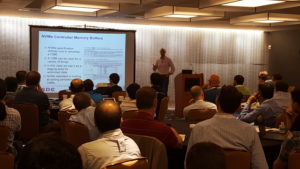 You’ll want to stream keynotes from Citigroup, Toshiba, DSSD, Los Alamos National Labs, Broadcom, Microsemi, and Intel – they’re available now on demand on SNIA’s YouTube channel, SNIAVideo.
You’ll want to stream keynotes from Citigroup, Toshiba, DSSD, Los Alamos National Labs, Broadcom, Microsemi, and Intel – they’re available now on demand on SNIA’s YouTube channel, SNIAVideo.
All SDC presentations are now available for download; and over the next few months, you can continue to download SDC podcasts which combine audio and slides. The first podcast from SDC 2016 – on hyperscaler (as well as all 2015 SDC Podcasts) are available here, and more will be available in the coming weeks.
SNIA thanks all its members and colleagues who contributed to make SDC a success! A special thanks goes out to the SNIA Technical Council, a select group of acknowledged industry experts who work to guide SNIA technical efforts. In addition to driving the agenda and content for SDC, the Technical Council oversees and manages SNIA Technical Work Groups, reviews architectures submitted by Work Groups, and is the SNIA’s technical liaison to standards organizations. Learn more about these visionary leaders at http://www.snia.org/about/organization/tech_council.
And finally, don’t forget to mark your calendars now for SDC 2017 – September 11-14, 2017, again at the Hyatt Regency Santa Clara. Watch for the Call for Presentations to open in February 2017.
SNIA and the Solid State Storage Initiative (SSSI) invite you to join them at Flash Memory Summit 2016, August 8-11 at the Santa Clara Convention Center. SNIA members and colleagues receive $100 off any conference package using the code “SNIA16” by August 4 when registering for Flash Memory Summit at 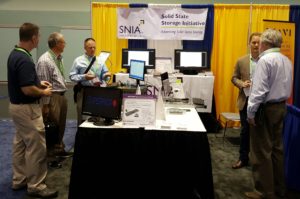 http://www.flashmemorysummit.com
http://www.flashmemorysummit.com
On Monday, August 8, from 1:00pm – 5:00pm, a SNIA Education Afternoon will be open to the public in SCCC Room 203/204, where attendees can learn about multiple storage-related topics with five SNIA Tutorials on flash storage, combined service infrastructures, VDBench, stored-data encryption, and Non-Volatile DIMM (NVDIMM) integration from SNIA member speakers.
Following the Education Afternoon, the SSSI will host a reception and networking event in SCCC Room 203/204 from 5:30 pm – 7:00 pm with SSSI leadership providing perspectives on the persistent memory and SSD markets, SSD performance, NVDIMM, SSD data recovery/erase, and interface technology. Attendees will also be entered into a drawing to win solid state drives.
SNIA and SSSI members will also be featured during the conference in the following sessions:
Finally, don’t miss the SNIA SSSI in Expo booth #820 in Hall B and in the Solutions Showcase in Hall C on the FMS Exhibit Floor. Attendees can review a series of updated performance statistics on NVDIMM and SSD, see live NVDIMM demonstrations, access SSD data recovery/erase education, and preview a new white paper discussing erasure with regard to SSDs. SNIA representatives will also be present to discuss other SNIA programs such as certification, conformance testing, membership, and conferences.
There are many permutations of technologies, interconnects and application level approaches in play with solid state storage today. In fact, it is becoming increasingly difficult to reason clearly about which problems are best solved by various permutations of these. That’s why the SNIA Ethernet Storage Forum, together with the SNIA Solid State Storage Initiative, is hosting a live Webcast, “Architectural Principles for Networked Solid State Storage Access,” on June 2nd at 10:00 a.m. PT.
As our presenter, we are fortunate to have Doug Voigt, chair of the SNIA NVM Programming Technical Working Group and a member of the SNIA Technical Council. Doug will outline key architectural principals that may allow us to think about the application of networked solid state technologies more systematically, answering questions such as:
I hope you’ll register today and join us on June 2nd for an hour that is sure to be insightful.
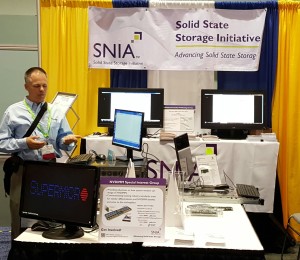 If you are in Silicon Valley or the Bay Area this week, SNIA welcomes you to join them and the Solid State Storage Initiative April 13-14 at the Santa Clara Convention Center for Open Server Summit 2016, the industry’s premier event that focuses on the design of next- generation servers with topics on data center efficiency, SSDs, core OS, cloud server design, the future of open server and open storage, and other efforts toward combining industry-standard hardware with open-source software.
If you are in Silicon Valley or the Bay Area this week, SNIA welcomes you to join them and the Solid State Storage Initiative April 13-14 at the Santa Clara Convention Center for Open Server Summit 2016, the industry’s premier event that focuses on the design of next- generation servers with topics on data center efficiency, SSDs, core OS, cloud server design, the future of open server and open storage, and other efforts toward combining industry-standard hardware with open-source software.
The SNIA NVDIMM Special Interest Group is featured at OSS 2016, and will host a panel Thursday April 14 on NVDIMM technology, moderated by Bill Gervasi of JEDEC and featuring SIG members Diablo Technology, Netlist, and SMART Modular. The panel will highlight the latest activities in the three “flavors” of NVDIMM , and offer a perspective on the future of persistent memory in systems. Also, SNIA board member Rob Peglar of Micron Technology will deliver a keynote on April 14, discussing how new persistent memory directions create new approaches for system architects and enable entirely new applications involving enormous data sets and real-time analysis.
SSSI will also be in booth 403 featuring demonstrations by the NVDIMM SIG, discussions on SSD data recovery and erase, and updates on solid state storage performance testing. SNIA members and colleagues can register for $100 off using the code SNIA at http://www.openserversummit.com.
by Marty Foltyn
The discussion, use, and application of Non-volatile Memory (NVM) has come a long way from the first SNIA NVM Summit in 2013. The significant improvements in persistent memory, with enormous capacity, memory-like speed and non-volatility, will make the long-awaited promise of the convergence storage and memory a reality. In this 4th annual NVM Summit, we will see how Storage and Memory have now converged, and learn that we are now faced with developing the needed ecosystem. Register and join colleagues on Wednesday, January 20, 2016 in San Jose, CA to learn more, or follow http://www.snia.org/nvmsummit to review presentations post- event.
The Summit day begins with Rick Coulson, Senior Fellow, Intel, discussing the most recent developments in persistent memory with a presentation on All the Ways 3D XPoint Impacts Systems Architecture.
Ethan Miller, Professor of Computer Science at UC Santa Cruz, will discuss Rethinking Benchmarks for Non-Volatile Memory Storage Systems. He will describe the challenges for benchmarks posed by the transition to NVM, and propose potential solutions to these challenges.
Ken Gibson, NVM SW Architecture, Intel will present Memory is the New Storage: How Next Generation NVM DIMMs will Enable New Solutions That Use Memory as the High-Performance Storage Tier . This talk reviews some of the decades-old assumptions that change for suppliers of storage and data services as solutions move to memory as the new storage
Jim Handy, General Director, Objective Analysis, and Tom Coughlin, President, Coughlin Associates will discuss Future Memories and Today’s Opportunities, exploring the role of NVM in today’s and future applications. They will give some market analysis and projections for the various NVM technologies in use today.
Matt Bryson, SVP-Research, ABR, will lead a panel on NVM Futures-Emerging Embedded Memory Technologies, exploring the current status and future opportunities for NVM technologies and in particular both embedded and standalone MRAM technologies and associated applications.
Edward Sharp, Chief, Strategy and Technology, PMC-Sierra, will present Changes Coming to Architecture with NVM. Although the IT industry has made tremendous progress innovating up and down the computing stack to enable, and take advantage of, non-volatile memory, is it sufficient, and where are the weakest links to fully unlock the potential of NVM.
Don Jeanette, VP and John Chen, VP of Trendfocus will review the Solid State Storage Market, discuss what is happening in various segments, and why, as it relates to PCIe.
Dejan Vucinc, HGST San Jose Research Center will discuss Latency in Context: Finding Room for NVMs in the Existing Software Ecosystem. HGST Research has been working diligently to find out where is there room in the existing hardware/software ecosystem for emerging NVM technology when viewed as block storage rather than main memory. Vucinc will show an update on previously published results using prototype PCI Express-attached PCM SSDs and our custom device protocol, DC Express, as well as measurements of its latency and performance through a proper device driver using several different kinds of Linux kernel block layer architecture.
Arthur Sainio, Director Marketing, SMART Modular and Co-Chair, SNIA NVDIMM SIG, will lead a panel on NVDIMM. discussing how new media types are joining NAND Flash, and enhanced controllers and networking are being developed to unlock the latency and throughput advantages of NVDIMM.
Neal Christiansen, Principal Development Lead, Microsoft, Microsoft will discuss Storage Class Memory Support in the Windows OS. Storage Class Memories (SCM) have been the topic of R&D for the last few years and with the promise of near term product delivery, the question is how will Windows be enabled for such SCM products and how can applications take advantage of these capabilities.
Jeff Moyer, Principal Software Engineer, Red Hat will give an overview of the current state of Persistent Memory Support in the Linux Kernel.
Cristian Diaconu, Principal Software Engineer, Microsoft will present Microsoft SQL Hekaton – Towards Large Scale Use of PM for In-memory Databases, using the example of Hekaton (Sql Server in-memory database engine) to break down the opportunity areas for non-volatile memory in the database space.
Tom Talpey, Architect File Server Team, Microsoft, will discuss Microsoft Going Remote at Low Latency: A Future Networked NVM Ecosystem. As new ultra-low latency storage such as Persistent Memory and NVM is deployed, it becomes necessary to provide remote access – for replication, availability and resiliency to errors.
Kevin Deierling, VP Marketing, Mellanox will discuss the role of the network in developing Persistent Memory over Fabrics, and what are the key goals and key fabric features requirements.